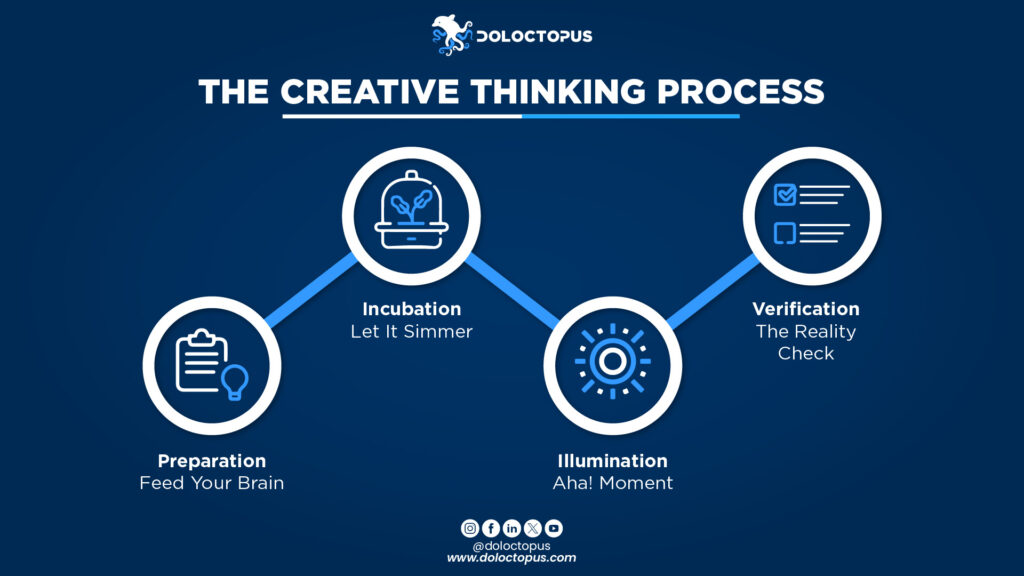Have you ever wondered how the people you hear about in the media, come up with those mind-blowing, out-of-the-box ideas? Whether it’s an innovative invention, a unique piece of art, or a perfect solution to a problem, creativity seems like magic. But here’s a secret: it’s not magic at all. It’s a process—the creative thinking process. And guess what? By exploring the work of Graham Wallas, a pioneer in the study of creativity, and his four stages—preparation, incubation, illumination, and verification—you can master it too.

Step 1: Preparation – Feed Your Brain
Think of your brain as if it were a sponge. To create, you need to first soak up as much knowledge and experience as possible. This is where the preparation phase comes in. Read, travel, talk to people from different walks of life, and expose yourself to various cultures and ideas. The more diverse your experiences, the richer your mental library becomes.
According to James Webb Young in his book A Technique for Producing Ideas, creativity often comes from combining existing elements in a new way. So, the more elements you have, the more potential combinations you can make!
Step 2: Incubation – Let It Simmer
After you’ve fed your brain with information, or when you hit a mental wall and can’t think of new ideas, it’s time to step back and let it all simmer. This phase is called incubation. It might feel like you’re not doing anything productive, but your subconscious mind is hard at work. Have you ever noticed how some of your best ideas come to you while you’re taking a shower, going for a walk, or drifting off to sleep? That’s incubation in action!
Graham Wallas, a pioneer in the study of creativity, highlighted incubation as a critical stage in the creative process. He suggested that taking breaks and giving your mind time to subconsciously process information can lead to surprising insights.
Step 3: Illumination – Aha! Moment
Now comes the exciting part—the illumination phase. This is when the light bulb goes off, and you suddenly see the solution or idea clearly without the need for any light. It’s that “Aha!” moment that makes all the preparation and incubation worthwhile. But remember, these moments often come when you least expect them, so always be ready to jot down your ideas. Keep a notebook handy, or use a note-taking app on your phone.
Step 4: Verification– The Reality Check
Once you’ve had your brilliant idea, it’s time to put it to the test. This is the verification phase. Not every idea is a winner, and that’s okay. You need to critically assess your idea’s feasibility and potential impact. Seek feedback from others and be open to constructive criticism. This will help you refine your idea and make it even better.
In their book Creativity, Inc., Ed Catmull and Amy Wallace emphasize the importance of candid feedback and collaboration in the creative process. They argue that honest feedback helps creators refine their ideas and achieve higher levels of creativity.
Finally, it’s time to bring your idea to life. Where you turn your creative concept into reality. The verification phase requires dedication and hard work. But seeing your idea come to life is incredibly rewarding.

Keep Practicing
Creativity isn’t a one-time thing; it’s a skill that you can develop and strengthen over time. Keep practicing these steps, stay curious, and don’t be afraid to take risks. Remember, every failure is just a stepping stone to success.
So, what are you waiting for? Start feeding your brain, let your ideas marinate, and get ready for those “Aha!” moments. Share this blog with the creatives in your life, thank us later!


